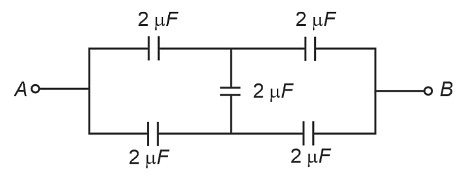Question:
To establish an instantaneous current of $2 A$ through a $1 \mu F$ capacitor; the potential difference across the capacitor plates should be changed at the rate of :
To establish an instantaneous current of $2 A$ through a $1 \mu F$ capacitor; the potential difference across the capacitor plates should be changed at the rate of :
Updated On: Aug 16, 2024
- $2 \times 10^4V/s$
- $4 \times 10^6V/s$
- $2 \times 10^6V/s$
- $4 \times 10^4V/s$
Hide Solution
Verified By Collegedunia
The Correct Option is C
Solution and Explanation
As, $C=\frac{Q}{V}=\frac{It}{V}$
$\Rightarrow \frac{V}{t}=\frac{I}{C}=\frac{2}{1\times10^{-6}}$
$=2\times10^{6}\,V/s$
Was this answer helpful?
0
0
Top Questions on Capacitors and Capacitance
- A capacitor of $10 \, \mu\text{F}$ capacitance whose plates are separated by $10 \, \text{mm}$ through air and each plate has area $4 \, \text{cm}^2$ is now filled equally with two dielectric media of $K_1 = 2$, $K_2 = 3$ respectively as shown in the figure. If new force between the plates is $8 \, \text{N}$, the supply voltage is ____ $\text{V}$.
- JEE Main - 2024
- Physics
- Capacitors and Capacitance
- A parallel plate capacitor of capacitance \( 12.5 \, \text{pF} \) is charged by a battery connected between its plates to a potential difference of \( 12.0 \, \text{V} \). The battery is now disconnected and a dielectric slab (\( \varepsilon_r = 6 \)) is inserted between the plates. The change in its potential energy after inserting the dielectric slab is ______ \( \times 10^{-12} \, \text{J} \).
- JEE Main - 2024
- Physics
- Capacitors and Capacitance
- In the following circuit, the equivalent capacitance between terminal A and terminal B is :

- NEET (UG) - 2024
- Physics
- Capacitors and Capacitance
- Two identical capacitors have same capacitance C. One of them is charged to the potential V and other to the potential 2V. The negative ends of both are connected together. When the positive ends are also joined together, the decrease in energy of the combined system is
- JEE Main - 2024
- Physics
- Capacitors and Capacitance
- A parallel plate capacitor has a capacitance C = 200 pF. It is connected to 230 V ac supply with an angular frequency 300 rad/s. The rms value of conduction current in the circuit and displacement current in the capacitor respectively are :
- JEE Main - 2024
- Physics
- Capacitors and Capacitance
View More Questions
Questions Asked in JEE Main exam
- Let \[\vec{a} = \hat{i} + \hat{j} + \hat{k}, \quad \vec{b} = -\hat{i} - 8\hat{j} + 2\hat{k}, \quad \text{and} \quad \vec{c} = 4\hat{i} + c_2\hat{j} + c_3\hat{k} \]be three vectors such that \[\vec{b} \times \vec{a} = \vec{c} \times \vec{a}.\]If the angle between the vector $\vec{c}$ and the vector $3\hat{i} + 4\hat{j} + \hat{k}$ is $\theta$, then the greatest integer less than or equal to $\tan^2 \theta$ is:
- JEE Main - 2024
- Vector Algebra
- 10 mL of gaseous hydrocarbon on combustion gives 40 mL of CO\(_2\)(g) and 50 mL of water vapour. The total number of carbon and hydrogen atoms in the hydrocarbon is ______ .
- JEE Main - 2024
- Hydrocarbons
- If each term of a geometric progression \( a_1, a_2, a_3, \dots \) with \( a_1 = \frac{1}{8} \) and \( a_2 \neq a_1 \), is the arithmetic mean of the next two terms and \( S_n = a_1 + a_2 + \dots + a_n \), then \( S_{20} - S_{18} \) is equal to
- JEE Main - 2024
- Arithmetic Mean
A body of mass 1000 kg is moving horizontally with a velocity of 6 m/s. If 200 kg extra mass is added, the final velocity (in m/s) is:
- JEE Main - 2024
- speed and velocity
- $\textbf{Choose the correct statements about the hydrides of group 15 elements.}$
A. The stability of the hydrides decreases in the order \(\text{NH}_3 > \text{PH}_3 > \text{AsH}_3 > \text{SbH}_3 > \text{BiH}_3\)
B. The reducing ability of the hydrides increases in the order \(\text{NH}_3 < \text{PH}_3 < \text{AsH}_3 < \text{SbH}_3 < \text{BiH}_3\)
C. Among the hydrides, \(\text{NH}_3\) is a strong reducing agent while \(\text{BiH}_3\) is a mild reducing agent.
D. The basicity of the hydrides increases in the order \(\text{NH}_3 < \text{PH}_3 < \text{AsH}_3 < \text{SbH}_3 < \text{BiH}_3\)
Choose the most appropriate from the option given below:- JEE Main - 2024
- p -Block Elements
View More Questions
Concepts Used:
Capacitor
Capacitors commonly known as Condensers are passive components, similar to a resistor. In capacitors, charges are usually stored in the form of an "electrical field". Electrical and electronic circuits depend on the same which is made up of two parallel metal plates that are not connected to one another. The two plates are separated by a non-conducting insulating medium called dielectric.
Uses of Capacitors:
- DC blocking capacitors block the DC and allows only AC to certain parts of the circuit.
- These are main elements of filters.
- They possess the ability to couple a section of the circuit to another.
Types of Capacitors:
- Ceramic capacitors are created by covering two sides of their tiny ceramic disc with silver and stacking them together.
- Film Capacitors are commonly used capacitors that are made up of different sets of capacitors.
- In an electrolytic capacitor metallic anode coated with an oxidized layer used as a dielectric.
- A Paper capacitor is also known as a fixed capacitor in which paper is used as the dielectric material.
Read More: Types of Capacitors



